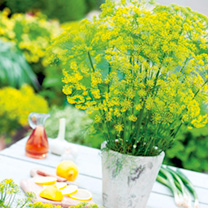How to Grow Dill – A Guide to Growing Dill
 With fern like foliage and delicate yellow/green flowers Dill is both decorative and a hardy annual herb .
With fern like foliage and delicate yellow/green flowers Dill is both decorative and a hardy annual herb .
Dill is suitable for container growing and is best grown in a 20–30 cm (8–12 inch) pot as it can reach 90 cm (36 inches) in height.
Varieties of Dill
Seed suppliers and garden centres offer just one variety of Dill.
Pests and Problems with Dill
Avoid sowing close to fennel as the plants will cross-pollinate and spoil the flavour of both herbs .
Sowing & Growing Dill
Dill is a decorative, hardy annual with fern like foliage and delicate yellow/green flowers.
It is suitable for growing in a container but as it can reach 90 cm (36 inches) in height is best grown in a 20–30 cm (8–12 inch) pot.
Dill can be sown successionally from early spring, into 8 cm (3 inch) pots.
When the plant reaches about 15 cm (6 inches) tall move it in to a larger pot .
Dill can be grown in full sun or light shade and needs to be supported with canes as it grows .
In cold weather, protect it with fleece or a cloche .
Harvesting Dill
Harvest between May and August.
The plants should be ready for harvesting from about eight weeks after sowing. The foliage can be cut down to ground level and the plant should re-grow providing a second flush.
Eating & Storing DIll
- Both the seeds and the leaves can be used in cooking. It is suitable for being dried or frozen.
- To stop its delicate flavour of the leaves being lost it is best to add at the end of cooking .
- For a change try Dill with lamb, salmon, herring, broad beans, peas, potatoes or in mayonnaise.
- The seeds are generally used in pickles, salad dressings and casseroles.
- Dill is widely used in Scandinavian and Eastern European dishes.



